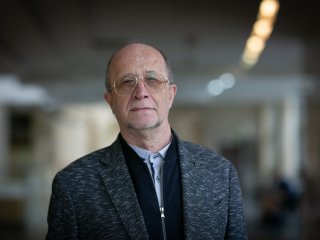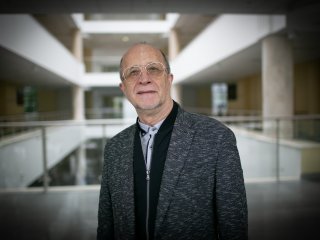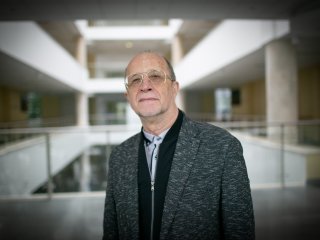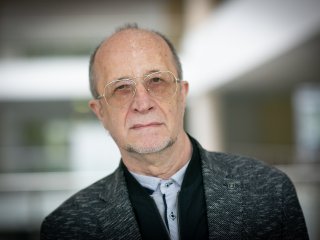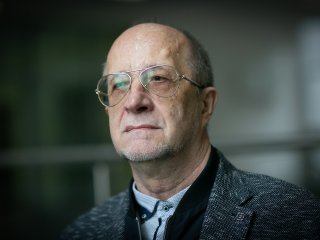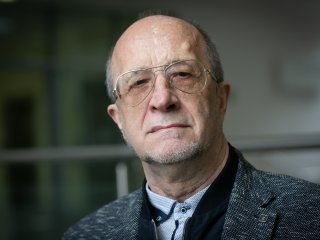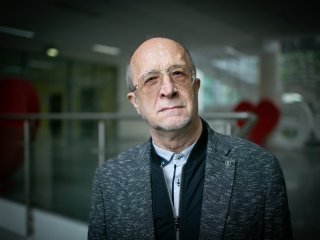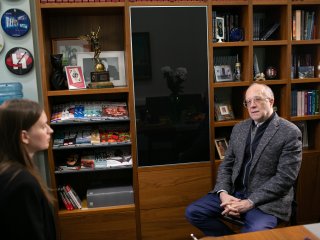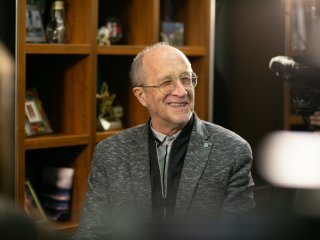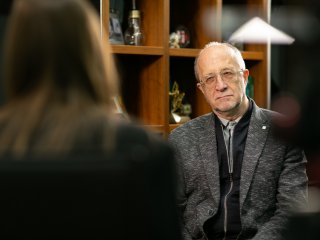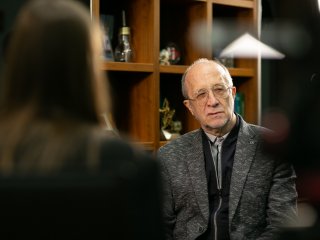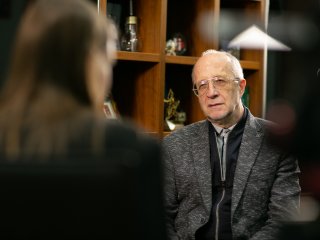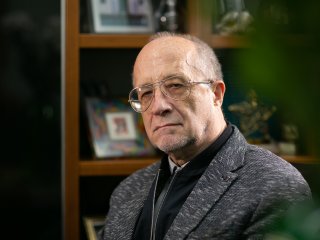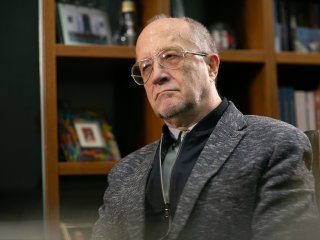The construction of a pilot demonstration energy complex with the BREST-OD-300 reactor continues at Rosatom’s Siberian Chemical Combine in Seversk. It will become a touchstone of the nuclear energy of the future that is going to rule out severe accidents at nuclear power plants, solve key raw materials and environmental problems of the nuclear industry. The demonstration of new technologies is carried out thanks to Proryv Project. What are its main tasks? Corresponding member of the Russian Academy of Sciences, Scientific Director of Proryv Project R&D Valery Rachkov tells us about it.
Valery Ivanovich Rachkov is a Corresponding Member of the Russian Academy of Sciences, Doctor of Technical Sciences, Professor, Scientific Director of Proryv Project R&D and a member of its technical committee.
− First of all, let’s talk about trends in the field of nuclear energy. Why is it necessary to create new fast neutron reactors? How do they differ from other types of installations?
− To begin with, the history of the world’s nuclear energy is divided into two periods – before the Chernobyl disaster and after it. The launch of the first nuclear power plant in Obninsk in 1954 with an electric capacity of 5 MW gave rise to the rapid growth of nuclear power with thermal neutron reactors: from 5 MWe in 1954 to 200 MWe in 1980. Of course, experts already understood at that time that they could not do with thermal reactors alone. After all, in the best case, there will be enough cheap fuel for them only for 150-200 years.
The industry needed fast neutron reactors, where not only uranium-235, of which only 0.7% is contained in the extracted natural uranium, can be energetically used, but also almost all the natural uranium. The bottom line is that in such a reactor, plutonium-239 can be obtained from uranium-238 nuclei, which is also considered a good fuel for nuclear power. Plutonium-239 is also produced in a thermal neutron reactor, but not intensively and efficiently enough.
Before the Chernobyl disaster, nuclear scientists made very optimistic forecasts. They planned to occupy up to 30% of global energy production by the 2020s. Of course, these hopes related to fast neutron reactors. At the same time, cheap and, as it seemed, safe thermal neutron reactors had to accumulate the necessary amount of plutonium to launch the first more expensive fast neutron reactors. After the Chernobyl disaster, the requirements for the safety of nuclear facilities were tightened. And, of course, a nuclear power with thermal neutron reactors has become much more expensive, a threat of losing its competitiveness is quite real.
Against this background, all forecasts related to the development of fast neutron reactors collapsed. There was such a situation that those fast neutron reactors we were counting on had not yet been developed, and those that were at our disposal remained very expensive. An erroneous opinion has spread among experts that fast neutron reactors would always be more expensive than thermal neutron reactors. Therefore, work on new-generation fast reactors around the world practically stopped.
BN-350 and BN-600 industrial fast neutron reactors were already operating in Russia at that time. France had the Phénix and Superphénix reactor plants, and Japan had the Monju experimental reactor. But in addition to the Chernobyl problem associated with an insufficient level of technical safety, the nuclear power industry with fast reactors faced the problem of nonproliferation of nuclear weapons. Let me remind you that during the operation of any reactor, plutonium accumulates in the core. It was for this purpose that reactors were created back then. Had there been no need for a nuclear bomb, I think that nuclear energy would have begun to emerge only now.
− Tell us about the Proryv Project history.
− Time passed, and gradually nuclear scientists began to recover after the Chernobyl accident, returning to old programs, including the programs for fast neutron reactors. So, in 1991, an article about the possibility of developing nuclear energy based on the principles of natural safety was published becoming a landmark for nuclear scientists. Its authors were the then director of the Research and Development Institute of Power Engineering (NIKIET) Yevgeny Olegovich Adamov and Professor Viktor Vladimirovich Orlov – one of the ideologists of the Proryv Project, which is being implemented in Russia today. The article, although it caused some excitement, was quickly forgotten. However, when Adamov became the Minister of Atomic Energy, we managed to adopt a strategy for the development of nuclear energy until 2050. It was approved by the government, and the entire world community learned about Russia’s plans to develop new nuclear energy – safe and competitive.
Nevertheless, the skepticism was indescribable. Thanks to Adamov, I traveled all over the world promoting this strategy. But, as they say, propaganda is propaganda, but something must be done. In 2010, we managed to receive funding under the New Generation Nuclear Energy Technologies federal targeted program. And again, thanks to Yevgeny Olegovich, it was possible to concentrate the allocated budget funds on what we call today the Proryv Project.
The Proryv Project is aimed at creating nuclear energy of natural safety. What does it mean? First, natural safety presupposes the absence of serious accidents requiring the population evacuation. The second principle relates to a consistent approach to the radiation-equivalent disposal of radioactive waste.
Conventionally, nuclear energy is associated primarily with a large radioactive impact on humans and their habitat. This is, of course, a myth. Nuclear power plants make a negligible contribution to the total radiation exposure. In addition, radioactivity is a common phenomenon, and we are all radioactive to some extent. It was important for us to prove to society that the waste accumulated in a nuclear reactor can be safely buried. But you can only bury what is safe. It is almost impossible to wait and control till radioactive waste becomes safe, as it will take hundreds of thousands or even a million years. Therefore, within the framework of the Proryv Project, technologies are being developed that turn long-lived radioactive waste into ordinary fission fragments. They can be safely buried after 300 years of controlled storage.
We proposed the so-called principle of radiation-migration equivalence of radioactive waste and fuel raw materials. The bottom line is that long-lived highly active waste in a fast neutron reactor will be transmuted into ordinary fission fragments and waste for disposal, after their long-term, but not very long-term controlled storage, and will have the same level of radioactivity as natural uranium deposits. Simply put, as much activity was taken out of the bowels, as much is buried in them.
The third principle of natural safety is related to the technological support of nuclear nonproliferation. As I have already mentioned, previously all reactors were designed with the possibility of producing weapons-grade plutonium. The cleaner plutonium was produced, the better, of course. Therefore, special blankets with uranium-238 were installed in thermal reactors, which made it possible to produce practically weapons-grade plutonium in them. Within the framework of the Proryv Project, we are creating reactors in which, without violating the principle of expanded reproduction of plutonium-239, there is no blanket where pure plutonium is produced. Thanks to the new methods of SNF reprocessing, we propose to work only with dirty plutonium, from which fuel for fast reactors is made. Due to this, the risk of leakage of weapons-grade material from the nuclear fuel cycle is significantly reduced. We even proclaimed a slogan: “From clean fuel, dirty waste, to dirty fuel, clean waste.”
Looking back, I cannot say that Proryv Project had a universally positive reception. In the first 10 years, it provoked resistance and even ridicule. Many people said that we would not succeed because we offer completely new technologies and a new coolant – liquid lead, and a new dense nuclear fuel – nitride uranium-plutonium fuel. And, of course, a different type of processing was required, a transition from water methods that provided the purity of plutonium separation to pyrochemical processing. This technology turned out to be quite difficult to master. After all, we were the first, we had nothing to rely on. Nevertheless, on the second attempt, this problem was also solved. But we understood that despite all our beautiful innovations, it would not work if the competitiveness of energy technology was not ensured. And our slogan became “From the stereotype – the more expensive, the safer, to the norm – the safer, the cheaper.” They believed in us, and the State Corporation began to invest in the project already from its own funds.
It is important that a pilot demonstration energy complex is already being built at Siberian Chemical Combine in Seversk, including the BREST-300 reactor with a remote nuclear fuel cycle, as well as a module for the fabrication and refabrication of uranium-plutonium (nitride) fuel for fast neutron reactors. As soon as the complex is fully operational, we will be able to demonstrate all technologies for large-scale nuclear power.
To date, Proryv Project is considered the world’s largest nuclear power project that has no equal anywhere in the world. Although abroad, they also understand that a closed nuclear fuel cycle with fast reactors is necessary. In 2000, Russian President Vladimir Putin addressed the United Nations at the Millennium Summit, calling for the sustainable development of mankind based on nuclear energy with fast neutron reactors and a closed nuclear fuel cycle. Immediately after that, in 2000, INPRO – International Project on Innovative Nuclear Reactors and Fuel – was initiated at the IAEA. Another project, Generation IV, appeared under the auspices of the United States, in which 4 reactor technologies out of 6 were related to fast reactors and with a closed nuclear fuel cycle. That is, there is understanding, but specific approaches are being implemented only in Russia based on the Proryv Project.
There are interesting studies conducted within the framework of INPRO, and we are actively participating in them. But, of course, this is a completely different scale. In fact, we have no competitors in this direction. But we would really like to have, if not friends, then at least colleagues. First of all, we are counting on China. If you look at the forecasts, only China and India are thinking about the development of large-scale nuclear energy. Everyone else, including us, is very modest about it.
− Why?
− Because we have enough oil and gas, which we use in huge quantities. These resources are relatively plentiful, and so far, everyone is satisfied. But since the green wave is coming, and the burning of organic resources is associated with the release of carbon dioxide into the atmosphere, there is an understanding that we need to prepare for radical changes and even more intensive development right now. At the same time, oil and gas reserves are not eternal. According to the most optimistic forecasts, relatively cheap oil, coal, and gas will last only for 150-200 years. That is why it is already necessary to create new technologies in the field of energy. And lay the foundations for large-scale nuclear power.
Our American colleagues understand this perfectly, but they don’t want to rush it. Why? I think it’s purely for economic reasons. They are waiting for Russia and China to create the necessary technologies, which can then be redeemed.
By the way, China is already forming serious programs, so we are actively cooperating with them. We care about the launch of large-scale nuclear power. If the Chinese suddenly start working on the old base – on the fast reactors of the first generation, where there is a large coefficient of reproduction and a sodium coolant, then we cannot exclude the occurrence of major accidents. And then you can put an end to nuclear energy. This cannot be allowed.
− That is, the nuclear power industry will not survive another major accident?
− Yes and no. If there is no choice, society will accept any, even not completely safe energy technology. What else can be done? If we keep in mind the public mood, then, of course, in the event of another accident, the population will say: “Close!” However, after a week they will say: “Open, we are freezing!” Therefore, to avoid such a paradoxical situation, it is necessary to develop a technology that will provide everyone with heat and electricity, but also allow us calmly and without fear to use nuclear energy technology of natural safety.
− You have already noted that the Proryv Project involves the formation of a closed nuclear fuel cycle. Tell us more about its specifics.
− To date, nuclear power uses an open nuclear fuel cycle. What is it about? For example, bark amounts to 10% of the total weight of the tree. How would we treat a woodcutter who cuts wood, cuts off only the bark, burns it to keep warm, and throws everything else away? We’d think he is crazy, wouldn’t we? So, in the modern nuclear industry, things are even worse – we have not even 10%, but 0.7% of raw materials at our disposal. Everything else turns into waste. A real technological madness!
On the contrary, the return to the cycle of what was previously supposed to be thrown out is a closure: the closed nuclear fuel cycle we’re talking about. In order to achieve maximum efficiency, new fuel must be made from the remains of old fuel, that is, from the materials extracted from spent fuel as a result of its processing. And in order to effectively burn such “dirty” fuel, fast reactors are needed. They allow us to burn, for example, a kilogram of fuel, while accumulating more than one kilogram of new fuel material.
− Which can be used again?
− Yes, from which fuel is produced again. Calculations allow us to say with confidence that this type of fuel will last for several thousand years, instead of two or three hundred when using oil, coal, and gas.
But in addition, a closed fuel cycle does not allow minor actinoids and long-lived radioactive waste to get into the ground. They are reused, breaking into fragments that can be safely buried after relatively short-term controlled storage.
− Now the whole world is passionate about the issue of carbon neutrality, the development of alternative types of energy. Is it possible to say that nuclear power gets more and more “competitors”?
− Of course, renewable energy sources should be used, but it is impossible to rely on them completely. After all, in fact, they cannot be controlled. For example, the wind is there, then not, the sun is shining, then not. Therefore, I consider renewable energy sources not a competitor to the new-generation nuclear power, but a kind of supplement. By and large, renewable energy sources are additional energy for rich countries. Everyone else needs cheap energy from nuclear power plants in the future, and now from traditional sources.
− Looking back at what has already been done and looking into the future, when do you think the new-generation nuclear power will be available to everyone?
− The demonstration of all elements of the new nuclear-power technological platform at the Siberian Chemical Combine is scheduled for the 2030s. Then the stage of technology commercialization will begin. We aim to make it competitive. Therefore, in about 15 years, the production of industrial energy complexes will be launched, which will be based on the technologies shown at the pilot demonstration energy complex.
Of course, by that time China will be on our heels. Even now, Chinese colleagues monitor our industry and track technologies and solutions. It seems to me that they will cooperate with us, but there is a great risk that China will be able to get ahead. Therefore, we will have to work in such a way as to maintain partnership relations, but also not allow colleagues from China to overtake us.
According to our forecasts, by the end of this century, fast neutron reactors operating in a closed nuclear fuel cycle will become the predominant generator of nuclear electricity in Russia. And the global transition to a closed fuel cycle energy based on fast reactors is already the task of the next century.
− Do new technologies imply that we will destroy old nuclear power plants or introduce new technologies into existing ones?
− It’s a good question. We are definitely not going to destroy anything. The strategy adopted by Rosatom State Corporation in 2018 urges us to be realistic: our new energy sector will grow on the foundation of the existing one. Those reactor installations that exist now will finalize their operational life.
Today we are talking about two-component nuclear power. What does this mean? We will use nuclear power plants with both thermal reactors and fast ones. But in any case, the reactors will have to operate in a closed nuclear fuel cycle, this is the most important thing. We will not break anything, only build.
− So, already at the end of this century?
− Yes. By the way, the Proryv Project is often compared with the nuclear project. But, of course, they are completely different. The nuclear project was based on the state’s task of defending the country. We are pursuing a different goal – we are learning to live peacefully in the future without an energy deficit for all mankind, while preserving, of course, the defense nuclear component.
− So, the motivation is different?
− Correct. The whole country worked on the nuclear project. Today we are creating something new in the conditions of acute shortage. It is good that we managed to create a compact group called “Proryv Project stream.” At one time, our main difficulty was to single out from the existing institutions the elite that would work on the project. Due to such a rather risky step from the viewpoint of production organization, we managed to assemble an excellent team, which, we hope, will be replenished with young people, and we will be able to finish the job together.
The interview was conducted with the support of the Ministry of Science and Higher Education of the Russian Federation and the Russian Academy of Sciences.

